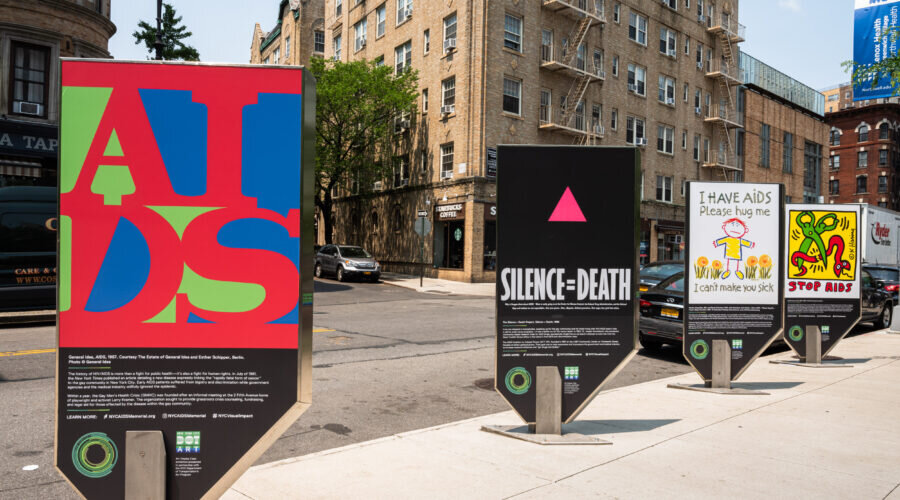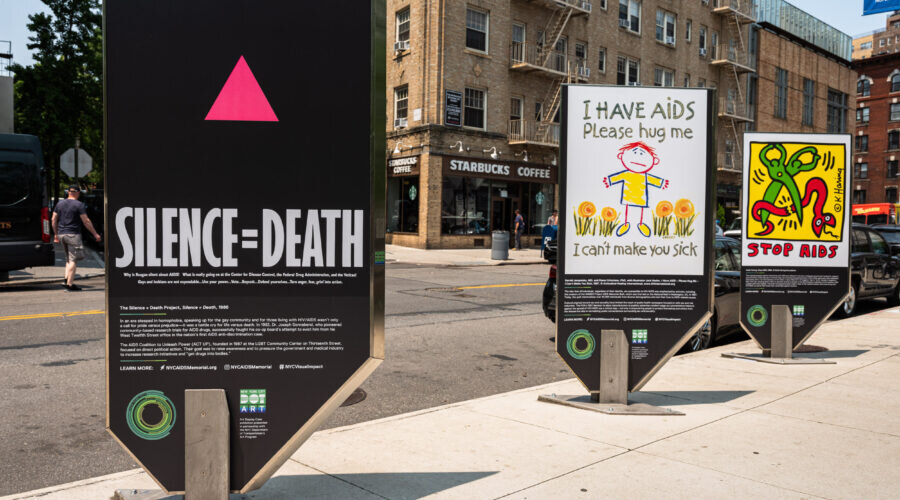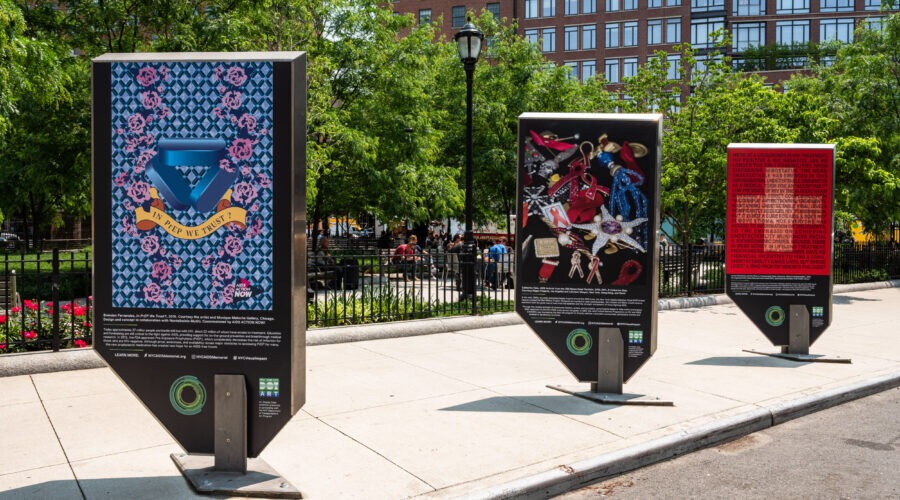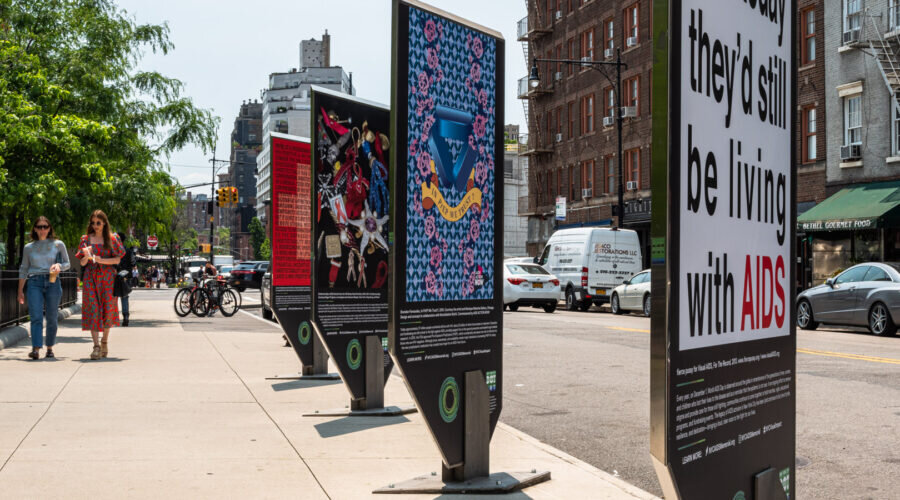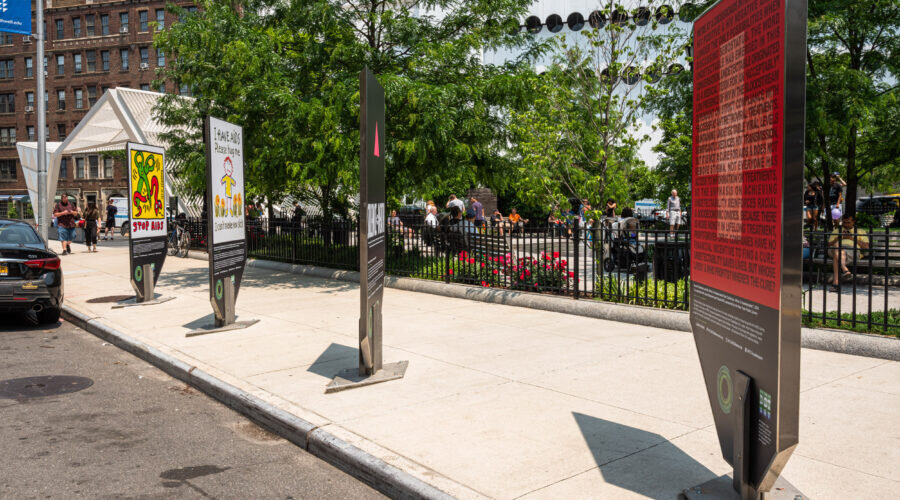Exhibition: Visual Impact: On Art, AIDS, and Activism
On June 1, 2019, to commemorate World Pride and the 50th anniversary of the Stonewall riots, the NYC AIDS Memorial will debut its newest site-specific art installation, Visual Impact: On Art, AIDS, and Activism. Situated adjacent to the Memorial Park on Greenwich Avenue, and presented in partnership with the NYC Department of Transportation’s Art Program, the educational exhibition showcases eight iconic works—by artists, graphic designers, and photographers—that represent the visual identity of the AIDS resistance from the mid-1980s through today.
Visual Impact continues the long-standing tradition of installing art in public spaces to inform and create awareness. The emotionally arresting art and thought-provoking text will inspire a renewed call to action. This important exhibition, steps away from the NYC AIDS Memorial, offers visitors the opportunity to understand and reflect on the full impact of the AIDS crisis.
The artworks were chosen by an advisory committee comprised of the following members:
Keith Fox, CEO of Phaidon Press and Artspace
John Carlin, Founder of Red Hot + AIDS
Esther McGowan, Executive Director, Visual AIDS
Christopher Tepper, Co-founder, The NYC AIDS Memorial
The history of HIV/AIDS is more than a fight for public health—it’s also a fight for human rights. In July of 1981, the New York Times published an article detailing a new disease expressly linking the “rapidly fatal form of cancer” to the gay community in New York City. Early AIDS patients suffered from bigotry and discrimination while government agencies and the medical industry willfully ignored the epidemic. Within a year, the Gay Men’s Health Crisis (GMHC) was founded after an informal meeting at the 2 Fifth Avenue home of playwright and activist Larry Kramer. The organization sought to provide grassroots crisis counseling, fundraising, and legal aid for those affected by the disease within the gay community.
In an era steeped in homophobia, speaking up for the gay community and for those living with HIV/AIDS wasn’t only a call for pride versus prejudice—it was a battle cry for life versus death. In 1983, Dr. Joseph Sonnabend, who pioneered community-based research trials for AIDS drugs, successfully fought his co-op board’s attempt to evict him from his West Twelfth Street office in the nation’s first AIDS anti-discrimination case. The AIDS Coalition to Unleash Power (ACT UP), founded in 1987 at the LGBT Community Center on Thirteenth Street, focused on direct political action. Their goal was to raise awareness and to pressure the government and medical industry to increase research initiatives and “get drugs into bodies.”
The idea that all individuals, regardless of their identity, are susceptible to HIV/AIDS was emphasized by activists, including the creators of the NAMES Project AIDS Memorial Quilt, which was first laid on the National Mall in Washington, DC, in 1987. Today, the quilt memorializes over 94,000 individuals from diverse demographics who lost their lives to AIDS-related causes. Cultural stigmas toward sex and sexuality have limited the reach of public health campaigns focused on safe sex and risk reduction. The FDA’s 1987 decision to allow manufacturers to publicly advertise condom usage as a preventative measure against the spread of HIV/AIDS was a critical step—not only in empowering people to protect themselves and others from the disease but also in normalizing public conversations surrounding sex and sexuality.
The ongoing prejudice against those living with AIDS was reflected in the lack of adequate government funding for research and prevention. Following years of clinical trials, the Food and Drug Administration (FDA) finally approved a new medication, Zidovudine (AZT), for the treatment of HIV/AIDS. In early 1989, ACT UP staged a “Kiss In” at St. Vincent’s Hospital in New York City, shutting down traffic on Seventh Avenue in protest of the discriminatory treatment of HIV-positive LGBT couples within the hospital. This direct and powerful action made it clear to the medical industry that those living with HIV/AIDS, as well as their loved ones, would fight against injustice.
Gaining access to proper medical care was just one of the many hardships faced by those living with HIV/AIDS during the height of the crisis. In 1990, Congress passed the Americans with Disabilities Act, under which those living with HIV/AIDS were finally granted legal protections against discrimination. Previous to this important legislation, many people lost their jobs, apartments, and even access to funeral burials—all because of their HIV-positive status.
In the early 1990s, as public awareness began to grow around the AIDS crisis, the New York–based collective Visual AIDS Artists’ Caucus created the Red Ribbon Project. Designed as a symbol to raise consciousness, the crossed red ribbon would come to represent both the great loss of lives from the epidemic and the strength and passion of those fighting AIDS. Through the tireless activism of community leaders, artists, and journalists, governments began to take notice and expand their responses to the HIV/AIDS crisis across the globe. In 1994, the Joint United Nations Programme on HIV and AIDS (UNAIDS) was founded as the first UN program to directly address vulnerable communities, particularly women and children in developing countries.
Today approximately 37 million people worldwide still live with HIV, about 22 million of whom have access to treatment. Education and fundraising are still critical to the fight against AIDS, providing support for on-the-ground prevention and breakthrough medical research. In 2012, the FDA approved Pre-Exposure Prophylaxis (PrEP), which considerably decreases the risk of infection for those who are HIV-negative. Although price, awareness, and availability remain major obstacles to accessing PrEP for many, the new prophylactic medication has created new hope for an AIDS-free future.
Every year, on December 1, World AIDS Day is observed around the globe in remembrance of the generations of men, women, and children who lost their lives to the disease and as a reminder that the epidemic is not over. In an ongoing effort to remove stigma and provide care for those still fighting, communities continue to come together to hold marches, vigils, educational programs, and fundraising events. The legacy of AIDS activism in New York City has been (and continues to be) one of pride, resilience, and dedication—bringing a loud, clear voice to the fight for our lives.
All photos by Kris Graves.


